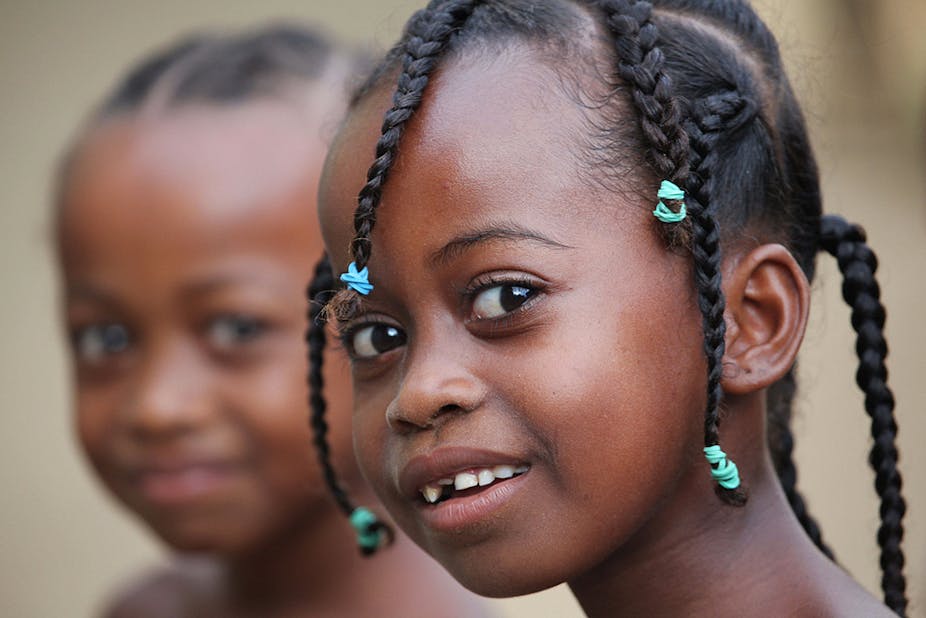Untangling the racial politics of hair has preoccupied casual observers and social analysts for centuries.
Cutting edge anthropological analyses suggest that contemporary hair styling is about “fashioning futures”, since African identities are “works in progress that refuse to be impoverished by dichotomies”.
However hair is also about the past and, specifically, cultural heritage. It is both tangible and intangible, a palpable thing that has long term symbolic value. As a changeable part of the human body, hair has long been modified for aesthetic and other ends. But skewed power structures entrenched by racism and sexism have meant that women, and particularly women of colour, have borne the brunt of stereotyping and prejudice. Even so, hair reveals the diversity of human history and cultural creativity.
Profoundly political
The politics of hair has deep roots. Ritually cleansing themselves, ancient Egyptian priests would shave their bodies and pluck their eyebrows every other day. In ancient Ghana, historical hair grooming involving hair combs and pins revealed leadership and status, while in nineteenth century Madagascar the Tsimihety did not cut their hair, presenting their tresses as a sign of their independence. American slave traders, on the other hand, shaved their captives’ heads supposedly to cleanse them. For many Africans, that act further stripped them of their dignity and symbolised cultural death.
In Europe and around the same time that the slave trade “boomed”, elaborate hairstyles flourished. This led to changes in European hair heritages. Increasing numbers of European men and women wore wigs and heavy makeup to signal their newfound wealth and status. Powdered and carefully coiffed, the wigs concealed undesirable odours and emerging ailments. Entire retinues of people were required to design, maintain and style the wigs.
Europeans promoted and entrenched racist discourses in slave and colonial society. In Zanzibar and Mauritius the short hair of African descendants was derisively described as pepper corns or sugar, major crops of the slave colonies. In South Africa, racist references to kort kop (short head) links short hair with inferior intelligence. The association of short hair with deficiency even makes it into song “jou hare kan nie pom-pom nie” (your hair cannot be tied in a bun).
Hair acquires new meaning
But hairstyles are acquiring new meaning. In Madagascar women wear “braids of love” to signal (from afar) a woman’s sole interest in marriage. At marriage, a woman will ask her sister-in-law to braid her hair to symbolise the strengthening of the marital bond between the families. Many Africans living in America today (and many African South Africans) wear their hair in dreadlocks to publicly validate the natural texture of their hair and symbolise a return to roots. Women everywhere are relinquishing “white crack” - chemical relaxers.
Increasingly, people are deliberately setting out to show that they don’t aspire to “western” ideas of beauty. The Himba people in Namibia braid and colour their hair and body with butter, fat and ochre. The mixture beautifies and protects their skin from the sun. Himba women may take up to 12 hours to do their hair.
Innumerable variations of cornrows and dreadlocks in South Africa, Malawi, Lesotho and Botswana also showcase the diversity of hair heritage in southern Africa.
As a black woman who has done some interesting things to her own hair, I would say that hair heritage is profoundly gendered. It reflects not only racism but the impact of patriarchy in society. Many rituals of womanly beauty, including hair styling, involve making a woman look younger. Fulfilling a patriarchal desire for youthfulness, women have endured the challenge of acquiring longer hair. Anyone who has had their hair braided in singles or cornrows knows about waiting for the “tightness” to subside and the fact that the pain might drive you to find a toothpick to loosen those unhappy baby hairs.
Clearly then, there is more to hair politics than hair straightening. What about the association of hairlessness with femininity in the “Brazilian”? Women of all colours routinely request a “Brazilian” or a “Hollywood”, rituals of intimate depilation and purification. Contemporary women regardless of colour are modifying the hair they inherited. Billions subject themselves to plucking, waxing, tinting, electrolysis, crimping and perming.
Interestingly, the rise of manscaping suggests that women are not alone in this hair styling frenzy. Long held masculine hair heritages and hairy reassertions of manhood seem to emerge in times of crisis.
The role of globalisation
Predictably, immigration and globalisation are diversifying hair heritages. Moroccan barbers have imported male nose and ear waxing to South Africa. The increasingly popular mixed martial arts trend, meanwhile, is encouraging an astonishing number of beard growers.
Given the rapid pace and intensity of globalisation, global trends may overcome local prejudices. The rise of metrosexual masculinity might well encourage more ritualistic waxing of backs, cracks and sacks. Until then, things remain unequal.

